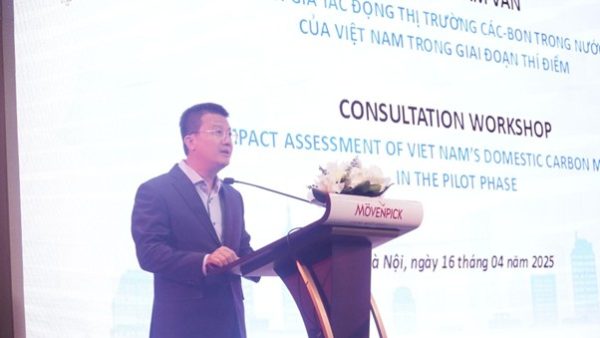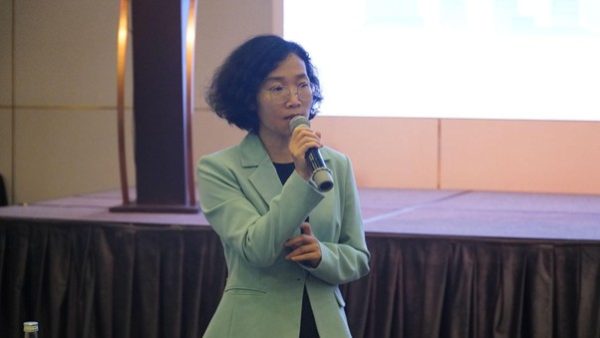On the morning of April 16, 2025, in Hanoi, Vietnam Energy and Environment Consultancy Joint Stock Company (VNEEC), as the technical consultant under the project “Assessment of the Impact of the Greenhouse Gas Emissions Trading Scheme (ETS) and Carbon Credits in Vietnam” jointly organized by the Department of Climate Change (DCC), Ministry of Natural Resources and Environment (MONRE) and Southeast Asia Energy Transition Partnership (ETP) to organize the consultation workshop titled “Impact Assessment of Viet Nam’s Domestic Carbon Market in the Pilot Phase.”
The workshop also gathered representatives from the Ministry of Industry and Trade, Ministry of Finance, and Ministry of Construction, along with domestic and international experts on ETS and carbon markets, as well as other relevant stakeholders.

Photo: Mr. Nguyen Tuan Quang, Deputy Director General, DCC, MONRE
In his opening remarks, Mr. Nguyễn Tuan Quang, Deputy Director General of DCC, MONRE, emphasized that the workshop’s objective was to analyze, model, and evaluate the impacts of various design and management options for the carbon market. The ultimate goal is to provide recommendations for the DCC to consider in developing and finalizing the legal framework and necessary conditions for the effective implementation of the carbon market during the upcoming pilot phase.

Photo: Mr. John Robert Cotton, Deputy Director, ETP
Speaking on behalf of the sponsor, Mr. John Robert Cotton, Deputy Director of ETP, underscored the workshop’s role in connecting experts, regulatory agencies, and enterprises, thereby promoting cooperation in building an effective carbon market in Vietnam.
At the workshop, Mr. Le Thanh Tung, representing the Carbon Market Division of DCC, provided an update on the regulatory framework and roadmap for the domestic carbon market in Vietnam during the pilot phase. According to the plan, the pilot phase will be implemented from 2025 to 2028, with full-scale operation set to begin in 2029. The pilot will focus on three major emitting sectors: iron and steel, cement, and thermal power, aiming to foster a low-carbon economy, optimize costs, and enhance competitiveness. In the near future, Vietnam will continue to improve its institutional framework, strengthen technical capacity, and promote international cooperation to ensure the effective operation of the carbon market.
Mr. Frédéric Gagnon-Lebrun, expert from South Pole, shared international experiences regarding ETS management options, highlighting the importance of clearly defining the scope, establishing emissions caps, and selecting appropriate allocation methods. Additionally, Dr. Robert Ritz, an economist from the University of Cambridge, presented the economic and financial impacts of ETS and analyzed notable case studies such as the EU-CBAM and the UK-ETS. Both presentations emphasized that while international experience is valuable, the success of ETS in Vietnam will primarily depend on domestic commitment and the alignment of policy with the country’s specific development context.
Ms. Nguyen Hong Loan, Team Lead, updated the progress of the technical assistance, provided an in-depth analysis of the national context, and presented a proposed ETS management approach for Vietnam’s pilot phase. The ETS design process focuses on three key components: defining scope, setting the emissions cap, and allocating quotation. In line with the EU ETS, the scope was determined based on an analysis of greenhouse gas (GHG) emissions level and trade level. As a result, the three sectors selected for the pilot phase include thermal power, cement, and iron and steel production.
The proposed allocation method is based on the average emissions intensity per production type, with adjustment factors to account for growth and emissions reduction targets. The emissions cap is aligned with Vietnam’s Nationally Determined Contribution (NDC), which include: (1) unconditional targets, (2) conditional targets with international support, and (3) targets tied to both international support and the political declaration under the Just Energy Transition Partnership (JETP).
The study evaluated policy options for each target scenario under three configurations: (i) no ETS, (ii) ETS with a 10% offset quotation, and (iii) ETS with a 20% offset quotation. In total, 9 scenarios were developed to assess the potential impacts of ETS during the pilot phase.

Photo: Ms. Nguyen Hong Loan – Team Lead
Mr. Ho Cong Hoa, expert from the Academy of Policy and Development, presented the impact assessment results for these scenarios. Using a structural econometric model, the analysis was conducted at three levels: micro (individual emission sources), sectoral (thermal power, cement, iron and steel), and macroeconomic (GDP, consumption, consumer prices). The evaluation indicated that ETS implementation would significantly reduce the total compliance costs for enterprises across all scenarios. The thermal power sector is expected to achieve the greatest cost reductions, followed by iron and steel. The cement industry, due to its relatively low emissions reduction investment costs, could benefit from selling quotation to the market.
Overall, the investment cost across all three sectors was relatively low—ranging from 0.02% to under 2% of each sector’s total investment. The analysis also revealed that all NDC-compliant emission reduction scenarios would lead to a slight decrease in GDP. However, the scale of the impact was minimal, ranging from 0.00075% to 0.0208% of GDP. Notably, the scenario involving unconditional NDC targets with a 20% offset quotation resulted in the least negative impact on the economy, including consumer prices.
In addition, the implementation of ETS is expected to drive the restructuring of high-emission industries and create development opportunities for low-emission sectors and green technologies such as renewable energy, electrified transport, and energy-efficient manufacturing. This transition is also anticipated to result in labor market shifts, including gender and employment structure changes.
During the workshop, participants discussed key topics such as the allocation methodology, types of offset credits accepted during the pilot phase, and the roadmap for ETS implementation in Vietnam. This workshop represents an essential step in the policy consultation process, aiming to design an effective domestic carbon market that strikes a balance between economic development and GHG emissions reduction.
2,006 views, 10

Tags:
Bài viết liên quan